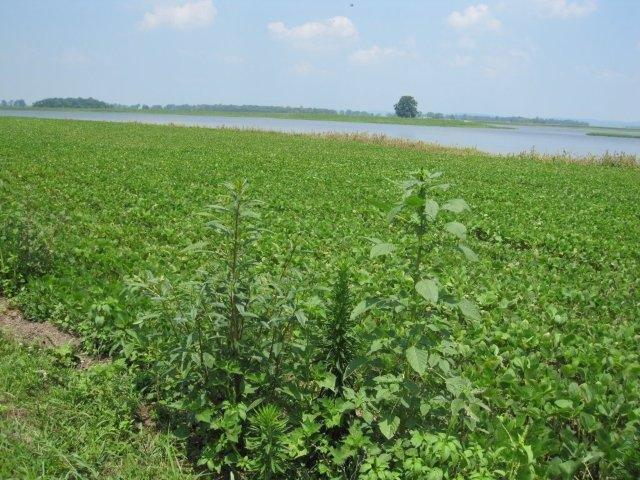EMBARGOED FOR RELEASE | September 08, 2013
New weapons on the way to battle wicked weeds
Note to journalists: Please report that this research was presented at a meeting of the American Chemical Society.
A press conference on this topic will be held Sunday, Sept. 8, at 10:30 a.m. in the ACS Press Center, Room 211, in the Indiana Convention Center. Reporters can attend in person or access live audio and video of the event and ask questions at www.ustream.tv/channel/acslive.
INDIANAPOLIS, Sept. 8, 2013 — A somber picture of the struggle against super-weeds emerged
here today as scientists described the relentless spread of herbicide-resistant menaces like pigweed and horseweed that shrug off powerful herbicides and have forced farmers in some areas to return to the hand-held hoes that were a mainstay of weed control a century ago.
The reports on herbicide resistance and its challenges, and how modern agriculture is coping, were part of a symposium on the topic at the 246th National Meeting & Exposition of the American Chemical Society (ACS), the world’s largest scientific society. The meeting with almost 7,000 scientific and other reports continues through Thursday in the Indiana Convention Center and downtown hotels. Abstracts of the symposium presentations appear below.
Costs of weed control have doubled or more in some areas and crop yields have suffered, according to experts.
“The problems associated with herbicide-resistant weeds are spreading and intensifying, especially weed species resistant to multiple products, including the mainstay of 21st century agriculture, the herbicide glyphosate,” said Bryan Young, Ph.D., who spoke at the symposium. He is with Southern Illinois University in Carbondale.
“More than 200 individual weed species have been confirmed resistant to at least a single herbicide, with infestations covering millions of acres in the United States and 60 other countries. It is spreading beyond soybeans and cotton. Weed management in corn has become more and more difficult in recent years due to herbicide-resistant weeds.”
Farmers, he pointed out, are not battling the mild-mannered dandelion or snow thistle that home gardeners visualize at the mention of “weed.” Rather, the battle involves nightmares like Palmer amaranth pigweed, which has been termed the master blueprint for the perfect weed. Under good conditions, Palmer amaranth grows an inch or more a day to heights approaching 10 feet with a stem tough enough to damage farm equipment. It crowds out crops and drains moisture and nutrients from the soil. Resistant plants thrive despite multiple soakings with glyphosate, and a single plant may produce almost 1 million seeds to perpetuate the menace.
Young said that growers are responding to such challenges by integrating alternative herbicides into their weed control programs, herbicides that work a different way and thus sidestep the resistance. They also are turning to herbicides that have residual activity in the soil, preventing weed seeds from growing into a new generation of weeds. When those measures fail, farmers are turning to cover crops to block weed growth and tilling the soil to kill emerged weeds or bury viable seeds deep below the soil surface.
Herbicides, however, remain the most effective tools for managing weeds in terms of overall control and for cost efficiency, Young emphasized. They have other benefits, such as reducing the need for plowing and other soil tillage — which is costly in terms of energy use and may contribute to soil erosion. And a number of products are on the way to help. They include new herbicide formulations that work in ways that sidestep the resistance mechanisms in today’s weeds. And they include crop seeds with genetic traits that enable farmers to apply herbicides to their fields without harming the crops.
“We must remember that herbicides or herbicide-resistant crop traits don’t create herbicide-resistant weeds,” Young said. “Rather, the use and management of these technologies to gain control of weeds by practitioners determines the risk of herbicide-resistant weeds evolving. We need to be better stewards of herbicides to reduce the impact of herbicide-resistant weed species.”
To automatically receive news releases from the American Chemical Society, contact newsroom@acs.org.
# # #
The American Chemical Society is a nonprofit organization chartered by the U.S. Congress. With more than 163,000 members, ACS is the world's largest scientific society and a global leader in providing access to chemistry-related research through its multiple databases, peer-reviewed journals and scientific conferences. Its main offices are in Washington, D.C., and Columbus, Ohio.
Media Contact
During the national meeting, Sept. 6-11, the contacts can be reached at 317-262-5907.
Michael Bernstein
m_bernstein@acs.org
202-872-6042
Michael Woods
m_woods@acs.org
202-872-6293
High-resolution image






